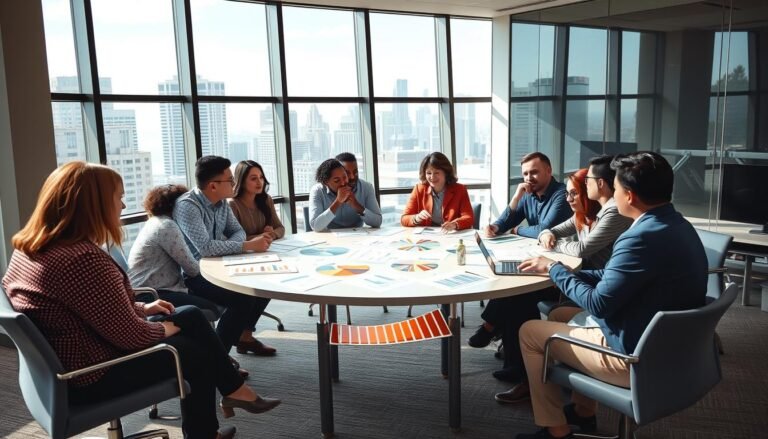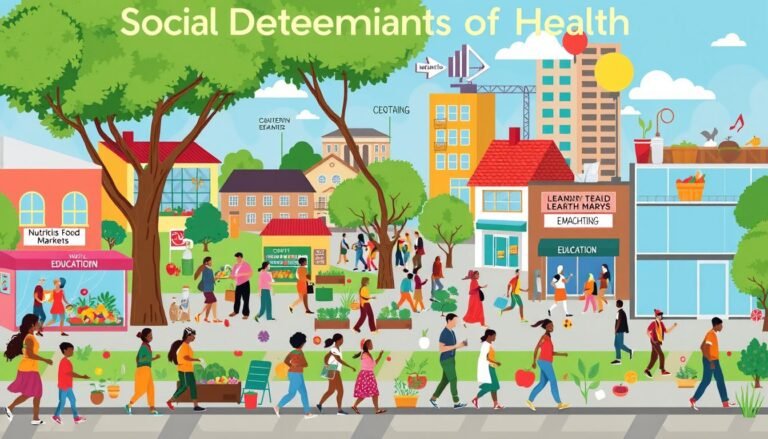Understanding the Sociology of Addiction
Have you ever thought about why some habits turn into addictions while others don’t? The study of addiction’s sociology gives us deep insights. It shows us that it’s not just about personal choices. Society greatly affects how we relate to substances and behaviors.
Addiction is more than a personal battle. It’s a major public health issue tied to our social lives. Everything from what we drink with friends to what doctors prescribe affects our risk of substance abuse.
Things like peer pressure, family issues, and money status help shape addictive habits. For instance, teens with poor family ties are more likely to use drugs. It’s not just about having willpower; it’s about our environment.
Our view of addiction has changed over the years. In the 1700s, it was seen as a nervous system problem. Now, we know it involves the brain. Yet, the social setting is still key. TV ads promote drinking, and social pressure pushes people towards bad habits.
Looking at addiction through sociology helps us see the full picture. It’s not just about helping individuals; it’s about tackling the social factors that drive substance abuse. By seeing addiction this way, we can find better ways to prevent and treat it.
Key Takeaways
- Addiction is influenced by social and environmental factors
- Societal views on addiction have evolved over time
- Family and peer relationships play a significant role in substance use
- Media and advertising can normalize addictive behaviors
- Social inequality contributes to addiction patterns
- Understanding addiction’s social aspects is crucial for effective treatment
The Social Construction of Addiction
Addiction is a complex issue shaped by social norms, cultural values, and historical contexts. Over time, how we see and define addiction has changed a lot. This change shows how society’s views on substance use have evolved.
Historical Perspectives on Addiction
Before, addiction was seen as a moral failing or a sign of weakness. Now, we see it as a complex health issue. It involves biology, psychology, and social factors.
Cultural Variations in Defining Addiction
Different cultures have different views on addiction. Some see certain substances as okay or even good, while others see them as harmful. These differences show how addiction is socially constructed.
Evolving Societal Attitudes Towards Substance Use
Views on substance use have changed a lot. For example, the American Psychiatric Association stopped seeing homosexuality as a mental disorder in 1973. This shows how society can change medical views. Changes in how we define addiction have also affected treatment and addiction rates.
“Over 75% of Americans take at least one prescribed drug, reflecting changing attitudes towards pharmaceutical use in society.”
The way we see addiction shows in how we tackle substance use issues. We’ve moved from seeing drug users as criminals to focusing on brain function. Psychological and social factors also play a big part in understanding addiction.
As society changes, so will our approach to addiction. It’s important to understand how addiction is socially constructed. This helps us make better policies and treatments that take into account cultural, historical, and social factors.
Social Factors Influencing Addiction Development
Addiction doesn’t happen alone. Social factors greatly affect a person’s risk of using substances. Things like family and friends play a big part in this.
Studies show that family and friends really matter to teens. A study by Bahr et al. (2005) found that being close to others can help or hurt a teen’s chances of using drugs. Things like family rules and school discipline help protect against addiction, but they’re getting weaker.
How we grow up in our communities also shapes our addiction risks. For example, young adults who are out and about often misuse prescription drugs (Kelly BC et al., 2013). This shows how what others do can make using drugs seem okay.
- Peer pressure drives substance use among youth
- Marketing in industries like hip-hop can glamorize drug use
- Stress relief is a common reason for substance abuse
Economic factors matter too. For example, how much tobacco costs affects who smokes (Han MA, 2019). This shows how big decisions can change our choices about using substances.
Knowing about these social risks is key to fighting addiction. By tackling the main causes in our communities, we can make places that support better choices and recovery.
Understanding the Sociology of Addiction
Sociology helps us see how social factors affect addiction. It looks at how people and their social surroundings interact. This view shows the deep connection between us and our social world.
Sociological Theories of Addiction
Sociological theories help us understand addiction in social settings. They show how society’s rules and interactions lead to addiction. For example, the labeling theory says that how society views people with addiction can change how they see themselves, leading to stigma.
The Role of Social Norms in Addictive Behaviors
Social norms greatly shape how we view substance use. In the West, alcohol and tobacco are legal and common, even though they’re harmful. On the other hand, cannabis and other substances are banned in many places. These norms affect how people use substances and how society reacts to it.
Socioeconomic Influences on Addiction Patterns
Socioeconomic factors play a big role in addiction rates and getting help. The U.S.’s War on Drugs has unfairly targeted minority communities, making social issues worse. The availability of harmful substances and activities is linked to more addiction, like how high taxes on cigarettes try to cut down on smoking.
| Societal Factor | Impact on Addiction |
|---|---|
| Prohibition | U.S. attempted alcohol prohibition (1919-1933) |
| Mental Health Support | Growing trend of online therapy platforms |
| Taxation | Heavy taxation on cigarettes to reduce consumption |
Knowing about the social side of addiction is key to making good prevention and treatment plans. It helps us tackle the complex social issues around substance use.
The Impact of Social Networks on Addiction
Social networks greatly influence how we handle addiction. They shape our habits and choices about using substances. Let’s explore how friends, family, and community affect addiction and recovery.
Peer Influence and Substance Use
Friends can influence our decisions about drugs and alcohol. A study showed that 47% of older teens use social networking sites. Being online can expose them to risky behaviors.
Peers might share posts about parties or drinking, making it seem okay. This can lead to harmful choices.
Family Dynamics and Addiction Risk
Family life can affect the risk of addiction. Parents who use substances may increase the chance their kids will too. But families can also protect against addiction.
Open talks about drugs and setting clear rules can help keep kids safe. This can reduce the risk of addiction.
Community Support Systems in Recovery
Communities are key in recovery. Support groups, like AA or NA, offer a chance to connect with others facing similar struggles. These groups provide encouragement and tips for staying sober.
Local clinics and rehab centers are also part of the community support system. They help people on the path to recovery.
| Social Network Type | Impact on Addiction |
|---|---|
| Peer Groups | Can increase substance use risk |
| Family | Can be protective or increase risk |
| Community Support | Aids in recovery process |
Understanding these social factors helps create better ways to prevent and treat addiction. By strengthening positive networks and addressing harmful ones, we can build healthier communities.
Societal Stigma and Its Effects on Addiction
Stigma is a big hurdle for those seeking addiction treatment. Even though we know more about mental health and substance use disorders, public views haven’t changed much. A survey showed that over 80% of Americans believe mental illness treatment works, but stigma still exists.
People with addiction often face social exclusion. The level of stigma depends on how close someone is to us. This leads to fewer job chances, less housing, and less access to healthcare, making recovery harder.
Stigma stops people from getting the help they need. Almost half of those needing mental health care say cost is a big reason they don’t get it. Other reasons include:
- Thinking problems can be solved on their own (26.5%)
- Worries about keeping things private (10%)
- Feeling scared of what others might think (10%)
Using person-first language helps reduce stigma. Calling someone a “substance abuser” makes things worse than saying “person with a substance use disorder.” This change in words can make care better for those fighting addiction.
| Medication | Effect on Overdose Risk |
|---|---|
| Methadone | Reduces risk by 50% |
| Buprenorphine | Reduces risk by 50% |
| Extended-release naltrexone | Reduces risk by 50% |
We need to tackle societal stigma to help addiction treatment and support social inclusion. By fighting wrong beliefs and promoting understanding, we can make a place where those with substance use disorders feel supported.
Addiction in Marginalized Communities
Substance abuse affects everyone, but it hits marginalized communities harder. These groups face extra hurdles because of things like poverty, race, ethnicity, and gender. These issues shape how addiction plays out.
Socioeconomic Disparities and Substance Use
People with lower incomes often battle drug or alcohol abuse more. Money troubles can push someone towards addiction, making it hard to escape. A UCLA study showed that those with less money often don’t have strong friends to turn to, making them more at risk.
Race, Ethnicity, and Addiction Patterns
Some racial and ethnic groups are more likely to struggle with addiction. For instance, the Appalachian region has dealt with deep poverty and an opioid crisis for years. The way people view addiction and the treatment they get also varies by community.
Gender Differences in Addiction Experiences
Men and women have different ways of getting into and out of addiction. Women might feel more judged when they try to get help, while men might find it hard to share their feelings in treatment. Treating each gender differently can lead to better recovery.
| Factor | Impact on Addiction |
|---|---|
| Low Income | Slightly higher substance abuse risk |
| Lack of Insurance | 1 in 5 forgo recommended treatment |
| Geographic Location | Some regions face higher addiction rates |
| Social Support | Lower income adults less likely to be married |
It’s key to understand these complex issues to help prevent and treat addiction in these groups. We need to tackle deep problems like poverty and bias. Also, offering care that fits the culture of these communities can help end addiction in these areas.
Public Policy and Addiction: A Sociological Perspective
Public policy greatly influences how society deals with addiction. Laws and social programs affect individuals, families, and communities a lot. They shape our response to substance abuse and addictive behaviors.
Many countries have used criminalization to fight drugs. This approach often fills prisons and hurts marginalized groups. Critics say it doesn’t solve the addiction problem and worsens social gaps.
On the other side, harm reduction aims to lessen the bad effects of drug use. It includes things like needle exchange, safe injection sites, and more naloxone access. Supporters believe it saves lives and helps people get into treatment.
Getting into treatment is still a big challenge. Many face high costs, stigma, and not enough services. Making treatments more available is key to tackling addiction.
“Addiction is not solely attributed to drugs; it results from the relationship between a person and the object of their addiction.”
Sociological views help us understand the complex link between public policy and addiction. They look at social structures, power, and culture. This helps us create better, fair ways to fight substance abuse and support recovery.
The Role of Media in Shaping Addiction Perceptions
Media greatly affects how we see addiction and substance use. From ads to social media, different platforms shape our views. They help us understand these complex issues better.
Advertising and Normalization of Substance Use
Ads often make drinking and using drugs seem okay, especially for young people. Research shows that seeing alcohol ads can make people start drinking and drink a lot. Young teens see these ads everywhere, which affects what they like and how much they drink.
Media Portrayal of Addiction and Recovery
TV shows and movies can make addiction look cool or not serious. Studies say seeing smoking in movies makes people more likely to start smoking. News also plays a part, using words that can make people see addiction in a bad light.
Social Media’s Influence on Addictive Behaviors
Social media brings new ways to deal with addiction. It’s a place where alcohol ads reach young people. Studies show that seeing alcohol online makes young people drink more. News stories about social media addiction also shape how we see being online.
| Media Type | Impact on Substance Use |
|---|---|
| Movies | Increased risk of smoking initiation |
| Alcohol Ads | Influence on drinking initiation and heavy drinking |
| Social Media | Association with alcohol use behaviors in youth |
It’s key to understand how media affects us to make better health messages and prevention plans. By seeing the impact of media, we can push for better ads and stories to fight the idea that using substances is normal.
Conclusion
The sociological perspective on addiction gives us deep insights. It shows how our actions and the world around us are connected. This view helps us see why social factors, culture, and big issues affect how we use substances.
Studies reveal that big life changes can change our substance use. For instance, getting married or having kids often means using less alcohol, cigarettes, and drugs. Also, having a good job can help reduce substance use more than a job that’s not stable.
Over time, how we prevent and treat addiction has changed. We’ve moved from methadone for heroin in 1965 to brain treatments for smoking in 2013. These new methods, along with understanding society, help us fight addiction better.
Seeing addiction as a complex issue helps us tackle it from all angles. This way, we can make prevention and treatment more effective. It’s crucial for reducing the impact of addiction on society.
Source Links
- Sociological Influences on Addiction Culture and Ethnicity
- 7.4 Explaining Drug Use
- Understanding Addiction in Sociology
- Social Constructionism and the Roots of Addiction – Non 12 Step Drug Rehab and Alcohol Treatment
- Addictions as a social construction: knowledge’s, public positioning, and state implementation of treatments
- Social Learning and Addiction
- What Are The Social Causes of Addiction?
- Sociological Causes Of Addiction And The Temperance Model
- Understanding Drugs from a Sociological Perspective
- Online Social Networking and Addiction—A Review of the Psychological Literature
- Research trends in social media addiction and problematic social media use: A bibliometric analysis
- Social Media Addiction and its Implications for Communication
- Understanding Stigma of Mental and Substance Use Disorders – Ending Discrimination Against People with Mental and Substance Use Disorders
- Stigma of Addiction
- Addiction and Moralization: the Role of the Underlying Model of Addiction
- Understanding the Relationship Between Poverty and Addiction
- The Division on Addiction – What is Addiction?: A Perspective
- Sociological Perspectives On Substance Abuse
- The Role of Media Reporting for Substance Use Stigma (Chapter 12) – The Stigma of Substance Use Disorders
- Media/Marketing Influences on Adolescent and Young Adult Substance Abuse
- Substance Use Changes and Social Role Transitions: Proximal Developmental Effects on Ongoing Trajectories from Late Adolescence through Early Adulthood
- Time to connect: bringing social context into addiction neuroscience







